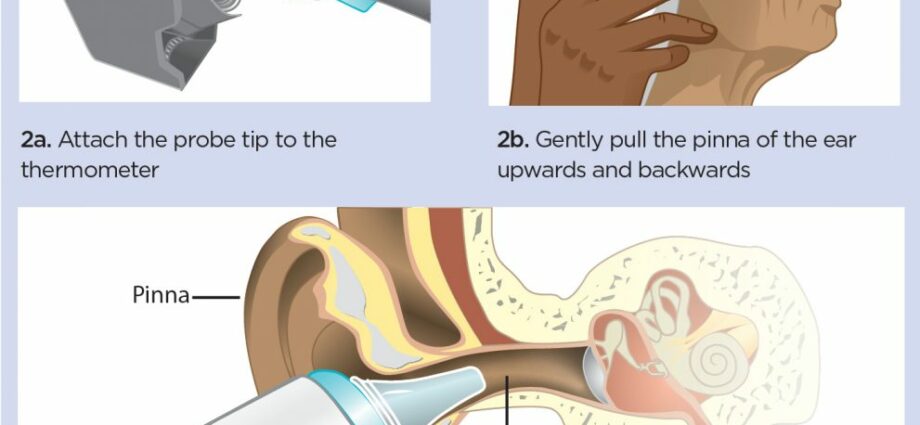Contents
Tympanic thermometer: how does it work?
The ear thermometer, also called an ear thermometer, is equipped with a conical infrared probe, which is introduced into the auditory canal, and which makes it possible to capture and measure the amplitude of the infrared radiation linked to the heat which is released from the eardrum and surrounding tissue. The infrared radiation is sent to an electronic sensor which transforms it into an electrical signal. After processing of this signal by a microprocessor, the temperature is displayed on an LCD screen.
What is an ear thermometer?
The ear thermometer, also called an ear thermometer, is an electronic device equipped with a conical infrared probe (radiation emitted by hot bodies). It assesses the body’s temperature from the infrared radiation emitted by it, performing a series of measurements in less than a second and retaining the highest result.
Less invasive than the electronic thermometer, which provides a rectal, oral or axillary measurement (that is to say under the arm), it delivers faster information: less than 5 seconds against 30 to 60 seconds. This speed is linked to the way it works:
- in case of fever, the eardrum, which adjoins the cerebral artery used to regulate body temperature, becomes warm. It thus gives access to the body temperature which testifies to the instantaneous state of the patient;
- infrared radiation is emitted. This wave invisible to the naked eye will heat the heat sensor, called a thermopile, placed at the end of the thermometer;
- this heat sensor gets hot. On one side of the sensor is a heat absorber exposed to infrared radiation, on the other, a base at room temperature and between the two, an assembly of two metals whose welds are in contact with the absorber and the base . The temperature difference gives rise in this circuit to an electric current whose value is proportional to the temperature difference;
- body temperature is then calculated and displayed. The microprocessor indeed finds the body temperature by adding the temperature difference given by the thermopile to the ambient temperature measured by the independent temperature sensor. The temperature is finally displayed on the LCD display of the thermometer, which then emits an audible signal.
What is an ear thermometer used for?
The ear thermometer is a general diagnostic medical device used to measure body temperature in order to detect the onset of fever in children and adults, knowing that the normal temperatures measured by the tympanic route vary between 35,8 and 38 ° C.
Temperature measurement by the tympanic route is recommended in children from 2 years of age and in adults.
How is an ear thermometer used?
HOW TO USE
- Clean the ear with lukewarm water and a little olive or almond oil to help soften the earwax, which can affect the accuracy of the results;
- place a disposable, clean and suitable tip (or probe cover) on the probe of the device to protect the sensor, guarantee the hygiene of the thermometer and prevent possible infection;
- if you have no or no tips, be sure to disinfect the thermometer probe;
- turn on the device;
- Carefully position the probe in the ear canal as far as possible, until the thermometer completely fills the canal. Its conical tip prevents it from hitting the eardrum;
- to facilitate its insertion, gently pull the ear upwards and then backwards. This makes it possible to align the auditory canal on the eardrum, to release the latter properly;
- press the button above the device to measure. A beep is emitted at the start of the take;
- keep the thermometer in place until the audible signal indicating the end of the measurement, i.e. approximately 3 seconds later;
- remove the thermometer and read the temperature;
- if in doubt about the measurement, repeat the operation on the opposite ear.
Precautions for use
- Take the temperature away from any physical exertion, in a person normally covered and outside any very hot atmosphere;
- in case of otitis, take the temperature in the unaffected ear or in another part of the body with a suitable thermometer;
- wash your hands before and after taking a temperature;
- wait at least 30 seconds after 3 to 5 continuous measurements;
- clean the housing of the thermometer and the probe after each measurement with a swab or cotton cloth soaked in 70% isopropyl alcohol;
- make sure that no liquid enters the interior of the thermometer;
- never use abrasive cleaning agents, thinners or gasoline;
- never immerse the device in water or any other liquid;
- take care not to scratch the surface of the probe lens as well as the screen.
How to choose the right ear thermometer?
Developed in the early 90s, today there are various versions of the ear thermometer. The selection criteria include the following characteristics.
The use we are going to make of it
It is indeed necessary to take into account the size of the tip, the conical probe having to be able to insert correctly in the ear. In case of family use, it is preferable to opt for a model with interchangeable tip.
The characteristics of the device
It is also a question of verifying:
- the accuracy of the temperature measurements obtained. In general, the ear thermometer can give an approximate measurement of 0,2 ° C;
- the convenience of the device by focusing on models with sound or light alerts indicating the presence of fever;
- the ergonomics of the thermometer and in particular of its handle, to ensure a good grip. Some models have a non-slip handle;
- that the device complies with European manufacturing and safety standards.
In addition, some models offer the possibility of recording the last measurements taken. Finally, other “two-in-one” models combine the possibility of taking the temperature by the tympanic and frontal route.










